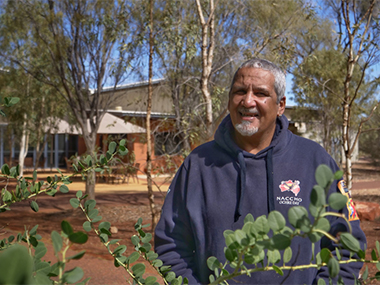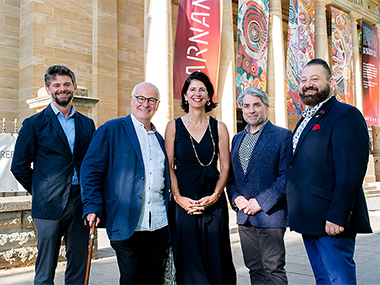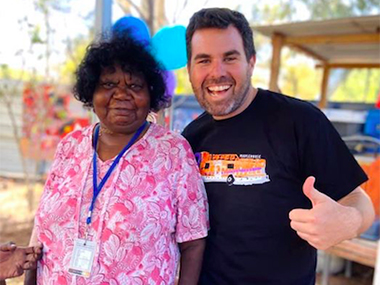Movement at the Station

Michael Liddle, one of the original Alice Springs gallery advisors, sticking with its recommendation that "the quiet of the Desert Park" was its best siting
Jeremy Eccles | 25.09.20
Author: Jeremy Eccles
News source: Research
It all seems to be happening in the fraught matter of building one or more Indigenous cultural institutions for Australia and the world to gain greater context and appreciation of the complexity of our First Nations cultures.
Not all of it is good! For instance, the newly re-elected Chief Minister of the NT swore on ABC radio when discussing the unhappy matter of the three year delay in establish a National Aboriginal Art Gallery (not a cultural institution) in Alice Springs. “I'm sick of fucking around", were his precise words. Then, out of the blue, the WA government threw $2m. into the pot for what Treasurer Ben Wyatt called a “great cultural missing link in Australia" to commence the planning of an Aboriginal Cultural Centre.
He obviously hasn't heard about either his own city's extensive Berndt Museum collection, or developments in Adelaide where Premier Stephen Marshall has (optimistically) determined that SA's Aboriginal Art and Cultures Centre will open in 2023 on the edge of the CBD after a good 12 months of quiet diplomacy involving the State's Aboriginal groups and the publication of a business case. Marshall has also announced the search for a First Nations leader to bring about “the delivery of a world-class cultural facility” that would “respect, acknowledge and celebrate Aboriginal stories through truth-telling of the old in new unique ways”.
Oddly, the only fly in the AACC's extremely positive ointment would seem to be the man who is, perhaps disappointed by the failure of his involvement in both Adelaide and Alice projects. Michael Lynch – pre-eminent arts administrator with leadership roles in Australia, the UK and Hong Kong - was on advisory committees for both the Alice gallery and a contemporary art gallery that the previous ALP government and the still-disgruntled SA Art Gallery wanted for Adelaide. Now, somewhat belatedly, he's complaining. “The election was two and a half years ago (and) this was supposedly a project that they (Labor) had committed themselves to do, and only now they’re advertising for someone to do it having had relatively limited discussions with the Indigenous community,” Lynch is reported as saying.
Wrong Michael – there have been extensive discussions, and your suggestion that a capable First Nations project and program leader will be hard to find is verging on the racist!
OK, with strong Aboriginal leadership in place, it will then be a matter of getting the right balance of skills and experience to support him/her or them. And a model of sorts seems to be emerging in Portland, Oregon, USA, where a $5-million, 112-year-old historic landmark building has been handed over gratis to an Indigenous-led arts organization. The Native Arts and Culture Foundation will use the building to program exhibitions, host cultural events, conduct residency programs, and house educational resources centred on Indigenous life.
In the West, that rather belated $2m project funding to “bring the Aboriginal story to the world and importantly tell that story to Australians by showcasing artefacts and pieces from across the State”, has not been received with total enthusiasm. The former Associate Director of the long-established Berndt Museum has pointed out that, like the SA Museum in Adelaide, they have a collection “of national and international significance. It holds cultural material from the South-West, Gascoyne, Pilbara, across the Kimberley and beyond state and territory borders nationally, as well as reaching out into Asia. Fully supported (which Dr Vanessa Russ obviously assumes the government isn't intending), the Berndt Museum Perth could become home to Australia’s leading Indigenous museum”.
Obviously, Dr Russ hasn't heard about Adelaide either – for the SA Museum's rather larger First Nations cultural collection has been offered lock, stock and barrel to the new AACC.
Which brings us sadly back to the NT. There's absolutely no reason why its National Aboriginal Art Gallery shouldn't exist beside SA's AACC – Alice is the epicentre of the Desert movement that began the current art efflorescence in Australia. Of course, much of the finest art of the past 50 years is now locked up. But a cooperative exhibition program with other institutions and private owners could make for the sort of drawcard that would attract visitors to Alice and help to maintain the cultural education of future generations of Desert people.
But the tripartite differences between the NT Government, the town council and local Arrernte leaders appear irresolveable. The government wants to site the gallery on the ANZAC Oval just off the town centre, but it would seem they're going to have to compulsorily acquire it for $3m after a legal battle with the obstinately conservative council. And, despite all claims to the contrary, the council is not satisfied that negotiations with local custodians who have insisted the gallery should only be sited outside town, preferably south of The Gap, have been
satisfactorily undertaken.
Oddly, the committee Michael Lynch sat on originally proposed a siting on the Desert Park, which is somewhat closer to town than the example of Hobart's MONA, constantly cited by government ministers. But appropriate negotiations with TOs failed to grasp that nettle 3 years ago.
One problem would seem to be a confusion of bodies representing Arrernte people. I've been attempting to sort this overlap out for myself and my readers (and possibly the NT Government!).
There's the Lhere Artepe, for instance, which is definitely a native title holder but does not actually have cultural authority on this matter, i.e. it can’t speak for Mparntwe itself, roughly Alice Springs north of The Gap. But Lhere Artepe is seen by governments as the ‘peak’ local body which appears to be a convenient one-stop-shop to consult. In reality, the way three geographical estate groups - Mparntwe, Irlpme, Antulye - have been rolled into this one body and are governed according to whitefeller rules, ie majority vote, is not suited to Arrernte decision-making structures, and tends to promote in-fighting.
For the group of custodians representing Mparntwe itself have said that Lhere Artepe does not speak for them. And they've rejected Anzac Oval, insisting on a location in the Desert Knowledge Precinct (that's NOT the Desert Park, by the way) south of The Gap for the gallery. This group includes Benedict Stevens and Doris Stuart, both Apmereke artweye for Mparntwe. Their family group numbering more than 30 includes their Kwertengerle, ‘managers’, who make sure they are doing the right thing. Unfortunately from the government's point of view, this group is clearly recognised by legislation as native title holders. Stuart is actually named in the determination; Stevens is not, but his father, now deceased, is.
Clearly, South Australians have noted this impasse and attempted a subtler approach. I wonder whether WA has also noticed? And could the newly appointed Minister for Central Australian Economic Reconstruction in the re-elected Labor government, Chansey Paech, a local MP, affect the issue? I fear not. For his only comment so far is that anti-ANZAC Oval candidates in the recent election didn't get many votes: “I don’t believe it’s a deal breaker”, he said with his head in the sand!
Which all leads me to suggest that one of my informants in Mparntwe might have hit the nail on the head: “I think it’s been a mistake all along to forefront location over processes, building the gallery from the ground up culturally speaking”.
Share this:
»  del.icio.us
»
del.icio.us
»  Digg it
»
Digg it
»  reddit
»
reddit
»  Google
»
Google
»  StumbleUpon
»
StumbleUpon
»  Technorati
»
Technorati
»  Facebook
Facebook
Contact Details

Michael Lynch (second left) with former Art Gallery of SA director Nick Mitzevich and former Gallery chair Tracey Whiting, all of whom have continued fighting for the discarded Adelaide Contemporary gallery project.

Mparntwe MP and Minister, Chansey Paech campaigning for dialysis and the Purple Bus with Ivy Nelson
Further Research
News Archive
- 02.10.20 | Maliwawa Rock Art
- 02.10.20 | Wonnangatta
- 25.09.20 | Movement at the Station
- 25.09.20 | Archie Has First Aboriginal Winner
- 17.09.20 | SUNSHINE SUPERGIRL
- 17.09.20 | Why not the Wynne?
- 08.09.20 | LONG JACK PHILLIPUS 1932-2020
- 02.09.20 | Consulting the Industry
- 27.08.20 | Goodies from Canberra
- 26.08.20 | Aboriginal Art is “An Exceptional Art Form”
- 25.08.20 | Tarnanthi 2020
- 24.08.20 | Art Fairs Exit - and Entrance
- 12.08.20 | Fairs Fare
- 07.08.20 | “The Art of the Nation”
- 06.08.20 | Art Is Fashionable
Advertising

